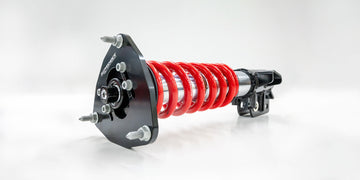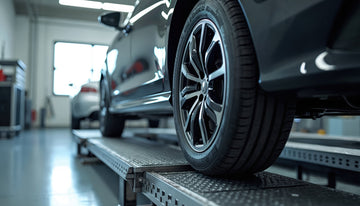Choosing between coilovers and lowering springs can be difficult because both options have their own advantages and disadvantages, and the right choice depends on your specific needs and preferences.
In this article, we will discuss what coilovers and lowering springs are, and compare the differences between the two so you know which one you need.
What are coilovers and lowering springs?
Coilovers and lowering springs are two types of suspension components used in cars to improve handling, performance, and aesthetics.
Coilovers
Coilovers are a type of adjustable suspension system that consists of a coil spring, shock absorber, and mounting assembly. The coil spring stretches and compresses in response to the car's movement, while the shock absorber dampens the movement of the unsprung weight of the vehicle and stabilises the car during cornering, braking, accelerating, and riding over bumps.
Coilovers can be customised for ride height, damping, and spring rates, allowing for a tailored suspension setup that can provide optimal performance for a specific driving style and track conditions.
Lowering springs
Lowering springs, on the other hand, are a type of suspension system that replaces the stock springs in a car with shorter springs that lower the ride height.
They often have a higher spring rate than stock springs, which can improve handling and reduce body roll, while still providing a comfortable ride. Lowering springs are generally less expensive than coilovers, but they do not offer the same level of adjustability and customisation.
Which ride height is better, adjustable or fixed?
The key difference between coilovers and lowering springs is the adjustability of ride height.
Coilovers can offer adjustable ride height, which means that you can adjust the height of the car to suit your needs or preferences. On the other hand, lowering springs provide a fixed ride height that cannot be adjusted once installed.
The adjustability of coilovers can have a significant impact on both performance and aesthetics. When it comes to performance, the ride height of a car can affect handling, traction, and body roll. Lowering a car can improve handling by lowering its centre of gravity, which can reduce body roll and improve traction, which can result in more predictable handling characteristics and better cornering ability.
However, lowering a car too much can have the opposite effect, making the ride harsher and compromising the suspension's ability to absorb bumps and uneven terrain. This is where the adjustability of coilovers comes in handy, allowing you to fine-tune the ride height to strike the perfect balance between performance and comfort.
However, the fixed ride height of lowering springs means that the car's stance cannot be adjusted once installed. This can limit your options for customisation and make it difficult to achieve the exact look you want.
Coilovers, on the other hand, offer much more flexibility in terms of aesthetics. You can adjust the ride height to achieve the perfect stance for your car, whether you want a slammed look or just a slight drop. This level of customisation can be a big advantage for car enthusiasts who want to create a unique look that sets their car apart from the rest.
Which option is better for performance and handling?
Both coilovers and lowering springs have their advantages and disadvantages when it comes to performance and handling. Coilovers offer adjustable ride height and damping settings, allowing for a more customised setup that can be tailored to specific driving conditions and preferences. This adjustability can improve traction, stability, and responsiveness, especially in high-performance driving situations.
Lowering springs, on the other hand, are fixed in terms of ride height and damping settings, which can limit their ability to be tailored to specific driving conditions. However, lowering springs can provide a stiffer suspension setup that can improve handling and cornering ability. They can also lower the centre of gravity, which can further enhance stability and responsiveness.
Which option is better for comfort and ride quality?
When it comes to comfort and ride quality, coilovers tend to offer more adjustability and better performance than lowering springs.
With coilovers, you can adjust the damping rate, preload, and other settings to fine-tune the ride for your specific needs. Lowering springs, on the other hand, often lead to a harsher ride, as they are designed to lower the vehicle's ride height and can result in a stiffer suspension.
However, it's important to note that the specific brand and model of coilovers or lowering springs can also have a significant impact on ride quality. Some coilovers are designed for high-performance driving and can be very stiff, while some lowering springs may be designed to provide a more comfortable ride.
Which option is better for ease of installation and maintenance?
In terms of ease of installation and maintenance, lowering springs are generally considered to be easier to install than coilovers.
Lowering springs simply replace the existing factory springs and require no additional adjustments or modifications. On the other hand, coilovers require more time and effort to install, as they have many more components that need to be adjusted and set up properly, such as the damping and ride height.
When it comes to maintenance, both coilovers and lowering springs require some degree of maintenance, but coilovers require more attention due to their increased complexity. Coilovers require periodic adjustments and servicing to ensure that they continue to perform optimally, whereas lowering springs require little to no maintenance once they are installed.
Which option is better for ease of cost and budget?
In terms of cost and budget, lowering springs are typically less expensive than coilovers.
Lowering springs generally cost less upfront and are easier to install, which can save on labour costs. Coilovers, on the other hand, tend to be more expensive due to their adjustable features and the inclusion of a damper for each corner of the vehicle. Additionally, coilovers often require professional installation, which can add to the overall cost.
However, it's important to note that investing in high-quality suspension upgrades, whether it be coilovers or lowering springs, can save money in the long run by preventing damage to other parts of the car and improving overall performance.
Which is better overall: coilovers vs lowering springs?
The choice between coilovers and lowering springs ultimately depends on your personal preferences, driving style, and budget. If you prioritise adjustability, customization, and overall performance, then coilovers may be the better option for you. However, if you are on a tighter budget and only looking to achieve a specific desired drop, then lowering springs may be a more cost-effective solution.
It is important to consider the potential long-term cost savings of investing in quality suspension upgrades. While coilovers may be more expensive upfront, their adjustability and durability can save you money in the long run by reducing the need for future suspension upgrades or replacements.





